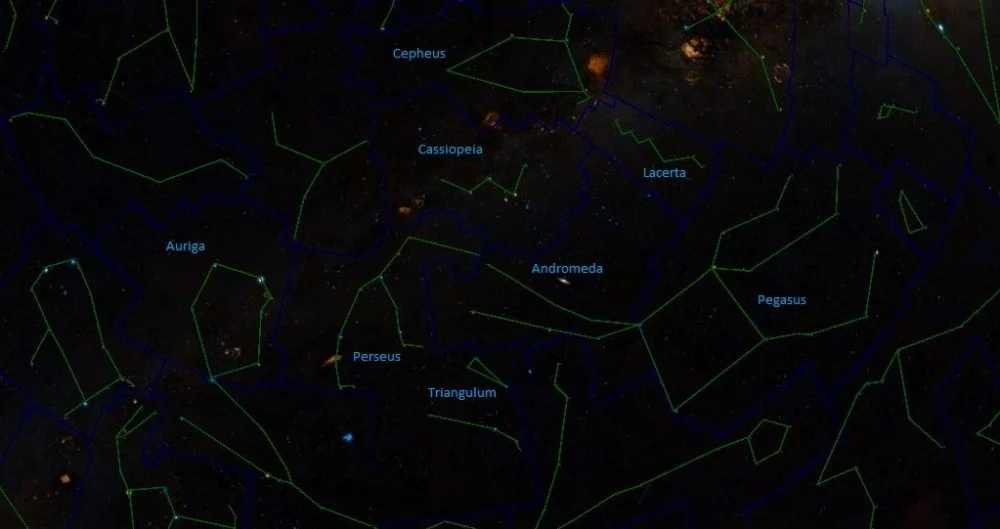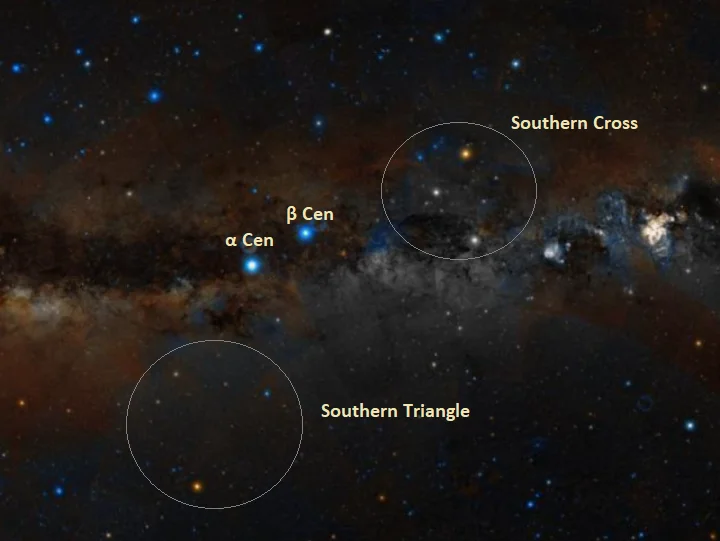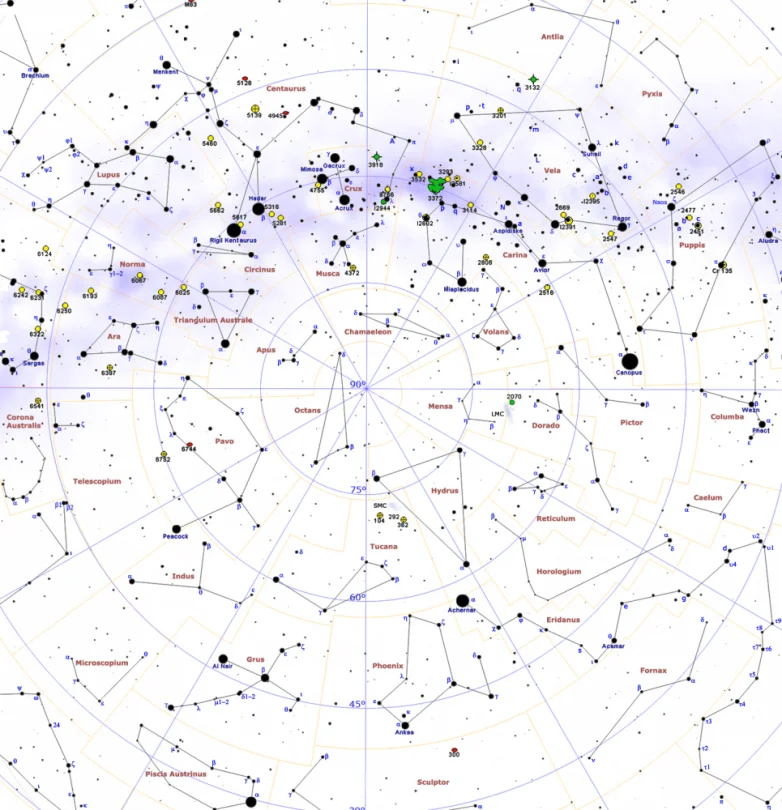There are 88 modern constellations recognized by the International Astronomical Union (IAU). The list of the modern constellations was adopted by the IAU in 1922. The constellation boundaries as we know them today were set in the late 1920s. 36 modern constellations lie principally in the northern celestial hemisphere, while 52 are found in the southern sky.
The list of the modern constellations and the abbreviations used for them were produced by American astronomer Henry Norris Russell and approved by the IAU in May 1922. Russell’s list corresponded to the constellations listed in the Revised Harvard Photometry star catalogue, published by Harvard College Observatory in 1908. The constellation boundaries were drawn by Belgian astronomer Eugène Delporte and officially adopted in 1928.
Who created the constellations?
The 88 modern constellations have different origins. Most of them are roughly based on the 48 ancient constellations catalogued by the Greek astronomer Claudius Ptolemy of Alexandria in his Almagest, an ancient astronomical treatise written in the 2nd century CE. These constellations are mostly associated with figures from Greek mythology. They include Andromeda, Cassiopeia, Perseus, Pegasus, Hercules, Orion, Ursa Major, Ursa Minor, Canis Major, Canis Minor, Eridanus, and the 12 zodiac constellations.
However, Ptolemy did not create these constellations. They were already well-known to observers long before his time. Even though they are called Greek constellations, they were not necessarily created by the Greeks. Depictions of some of the ancient constellations or the asterisms they are known for go back to prehistoric times and their creators are unknown.
Fifty of the modern 88 constellations are based on the Greek ones. Only one of Ptolemy’s constellations – Argo Navis – is no longer in use. Once the largest constellation in the sky, Argo Navis represented the ship of Jason and the Argonauts. It was divided into three smaller constellations – Carina, Puppis and Vela – by the French astronomer Nicolas-Louis de Lacaille in the 18th century. The three smaller constellations remain in use.

Perseus family of constellations, image: Wikisky
The constellation Coma Berenices (Berenice’s Hair) was known as an asterism to the Greeks, but it was not included on Ptolemy’s list. German cartographer Caspar Vopel is credited as the first to designate it as a constellation. Danish astronomer Tycho Brahe also listed it as a constellation in his 1602 star catalogue.
The remaining constellations – most of them located in the southern sky and invisible to the Greeks – were created during and after the Age of Discovery. Twelve were created by Dutch explorers Pieter Dirkszoon Keyser and Frederick de Houtman, who observed the southern sky on their journey to Indonesia in 1595. Most of these constellations were named after the animals that the explorers encountered south of the equator. This group includes Apus (Bird of Paradise), Chamaeleon, Dorado (the Dolphinfish), Grus (the Crane), Musca (the Fly), Volans (the Flying Fish), and Tucana (the Toucan).
The Dutch constellations were first depicted on 35-cm celestial globe designed by the Dutch-Flemish astronomer Petrus Plancius in 1597/1598. Plancius had trained Pieter Dirkszoon Keyser to make observations of the southern stars and, even though Keyser met his end during the expedition, his and Houtman’s star catalogue was delivered to Plancius.

The Southern Cross and the Southern Triangle, the asterisms that dominate the constellations Crux and Triangulum Australe, image: Wikisky
Plancius had previously depicted the southern constellations Crux and Triangulum Australe using what little information was available to him about the southern sky. He also depicted Columba (the Dove) on the small planispheres of his world map in 1592. In 1612 or 1613, he introduced eight more constellations on a 26.5-cm celestial globe. Only two of these – Monoceros (the Unicorn) and Camelopardalis (the Giraffe) – remain in use. The now obsolete constellations created by Plancius included Sagitta Australis (the Southern Arrow), Gallus (the Rooster), Apes (the Bee), and Cancer Minor (the Small Crab).
All the constellations that appeared on Plancius’ celestial globes were made famous after they appeared in German astronomer Johann Bayer’s Uranometria, published in Augsburg, Germany in 1603. Uranometria was the first star atlas to cover the entire sky.
Ten new constellations were added by Polish astronomer Johannes Hevelius in the 17th century. Seven of these – Canes Venatici (the Hunting Dogs), Lacerta (the Lizard), Leo Minor (the Smaller Lion), Lynx, Scutum (the Shield), Sextans (the Sextant) and Vulpecula (the Fox) – are still in use. Hevelius also created the constellations Cerberus, Mons Maenalus (Mount Maenalus), and Triangulum Minus (the Smaller Triangle), which are now obsolete. All these were depicted in his atlas of constellations Firmamentum Sobiescianum sive Uranographia (1687).

Constellations in the Bayer and Lacaille families, image: Roberto Mura
The 18th century French astronomer Nicolas-Louis de Lacaille, who divided Argo Navis, added another 14 constellations to the southern sky. Lacaille made his observations from the Cape of Good Hope in South Africa. The constellations he introduced are mostly faint, small, and invisible from mid-northern latitudes. He named most of them after scientific instruments. Lacaille’s constellations include Antlia (the Air Pump), Caelum (the Chisel), Fornax (the Furnace), Horologium (the Pendulum Clock), Microscopium (the Microscope), Octans (the Octant), Pyxis (the Compass), and Telescopium (the Telescope). All these constellations are still in use.
Below is the list of the modern 88 constellations, adopted by the International Astronomical Union (IAU) in the 1920s:
| Andromeda | Circinus | Lacerta | Piscis Austrinus |
| Antlia | Columba | Leo | Puppis |
| Apus | Coma Berenices | Leo Minor | Pyxis |
| Aquarius | Corona Australis | Lepus | Reticulum |
| Aquila | Corona Borealis | Libra | Sagitta |
| Ara | Corvus | Lupus | Sagittarius |
| Aries | Crater | Lynx | Scorpius |
| Auriga | Crux | Lyra | Sculptor |
| Boötes | Cygnus | Mensa | Scutum |
| Caelum | Delphinus | Microscopium | Serpens |
| Camelopardalis | Dorado | Monoceros | Sextans |
| Cancer | Draco | Musca | Taurus |
| Canes Venatici | Equuleus | Norma | Telescopium |
| Canis Major | Eridanus | Octans | Triangulum |
| Canis Minor | Fornax | Ophiuchus | Triangulum Australe |
| Capricornus | Gemini | Orion | Tucana |
| Carina | Grus | Pavo | Ursa Major |
| Cassiopeia | Hercules | Pegasus | Ursa Minor |
| Centaurus | Horologium | Perseus | Vela |
| Cepheus | Hydra | Phoenix | Virgo |
| Cetus | Hydrus | Pictor | Volans |
| Chamaeleon | Indus | Pisces | Vulpecula |